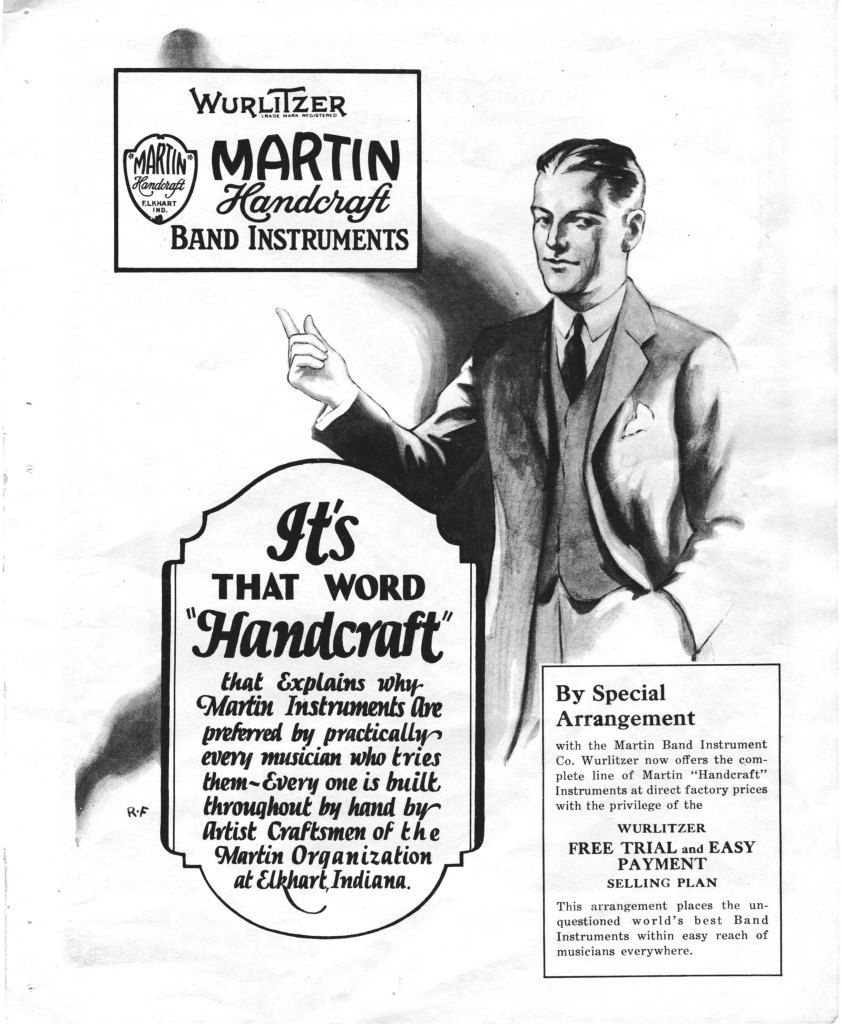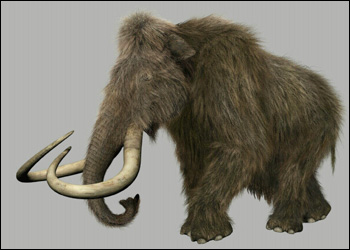Page 1 of 1
What constitutes a Martin Mammoth?
Posted: Wed Jan 30, 2013 6:09 pm
by manatee
Is it any large Martin tuba? Does a Handcraft qualify?
Re: What constitutes a Martin Mammoth?
Posted: Wed Jan 30, 2013 9:01 pm
by Paul Scott
Martin used the terms "Medium", "Monster" and "Mammoth". The term "Mammoth" was used only to describe BBb tubas/sousas/helicons while "Monster" was used only in reference to Eb tubas/sousas/helicons. To add to the confusion, the term "Medium" was applied to BBb and Eb instruments.
Basically, there were three bore sizes:
Eb Medium: .620;
Eb Monster/BBb Medium: .687
BBb Mammoth: .712 (not .730 as is often claimed).
Bells ranged from 17" (Medium Eb Bass) to 30" or more for a BBb Mammoth.
The word "Handcraft" was added to the Martin name in the Spring of 1924 as part of a big advertising push. Martins prior to that date are not marked Handcraft but are still top-quality instruments. There is a misconception that Martin made a Handcraft line and a "non-Handcraft" line-this is not so. The only budget-line that Martin was connected with was the "Indiana" line and those instruments are labeled as such. I've discovered this information through original catalogues, advertising from the '20s and my own instruments.
Re: What constitutes a Martin Mammoth?
Posted: Wed Jan 30, 2013 9:07 pm
by Paul Scott
And here's some ad copy from 1924 (Wurlitzer distributed Martin widely at the time):

Re: What constitutes a Martin Mammoth?
Posted: Thu Jan 31, 2013 8:54 am
by opus37
Prior to using the term "Handcraft", Martin used the term "Renowned". The term "Monster" was used as early as 1910 and maybe before that. Their niche was to produce the largest Eb and BBb instruments at the time to product greater volume.
For reference, the Renowned Monster Eb had a 0.687 bore, was 32.5 " tall and a 20" bell diameter. They came in high and low pitch. Actually, they produced a high pitch and supplied a main tuning slide extension to allow low pitch tuning.
They had 3 finished available, but I don't know the specifics of these finishes.
Re: What constitutes a Martin Mammoth?
Posted: Thu Jan 31, 2013 10:57 am
by eupher61
I dunno...I'll get itchecked with calipers, but using a tape measure my Mammoth is much closer to .750" than to .700...in fact it appears to be right on it.
Re: What constitutes a Martin Mammoth?
Posted: Thu Jan 31, 2013 12:16 pm
by GC
I wonder where the mouthpiece goes...

Re: What constitutes a Martin Mammoth?
Posted: Thu Jan 31, 2013 12:55 pm
by Paul Scott
Yes, Renown (sometimes Renowned) was a term used prior to the early 20's by Martin as a description in catalogues. I've never seen an instrument marked as Renown however, while Handcraft was engraved on the bell.
Re: What constitutes a Martin Mammoth?
Posted: Thu Jan 31, 2013 1:45 pm
by MartyNeilan
Paul Scott wrote:And here's some ad copy from 1924 (Wurlitzer distributed Martin widely at the time):

Leonardo DiCaprio sold tubas?

Re: What constitutes a Martin Mammoth?
Posted: Thu Jan 31, 2013 2:52 pm
by opus37
My Renowned Monster does not have Renowned or Monster engraved on the bell. It has Martin Band Instrument Co. Elkhart, ID.
Re: What constitutes a Martin Mammoth?
Posted: Wed Feb 06, 2013 11:33 am
by Uncle Markie
I think the "Mammoth" designation is asimply a holdover from older advertising. My Martin says "Handcraft" on the back of the bell (1930s vintage) as did Johnnny Evans' Martin (Johnny introduced me to the superiority of the Martin tuba on the Ringling Circus Band). "Handcraft" was Martin's top of the line until the "Committee" line of instruments were introduced in the 1940s - no "Committee" tubas however - the name just became "The Martin".
Regarding bore - .712 sounds about right. Martin tubas (at least the big BBb horns) used a combination of a sensible bore size, light valves and BIG tapers in the body of the instrument. That's where that big core of sound combined with nimble articulation comes from IMHO. I've played several instruments with bigger bore size that did not have a comparable core of sound that actually played "stuffy" compared to these old Martins. The Martin guys were smart - you never find any long, loopy leadpipes going into the valveset - this results in a pretty efficient tuba.
Martins were never "cheap" they were always more than a Conn or King. Unfortunately the tooling, designs, etc. are lost due to corporate mismanagement and shift away from professionals needs to catering to the tastes of the educational market. Martins disappeared about the same time Conn professional line instruments went away too. The first thing that disappears in the buying and selling of instrument companies are the professional instruments and that's what happened to Martin.
Mark Heter
Re: What constitutes a Martin Mammoth?
Posted: Wed Feb 06, 2013 7:38 pm
by pjv
Wasn't that the idea with the Kanstul CTU-900/4B 5/4 BBb tuba? (on the other hand, a .689″ doesn't sound very Martin-like).
Re: What constitutes a Martin Mammoth?
Posted: Thu Feb 07, 2013 1:10 am
by WilliamVance
hrender wrote:Given the trend towards more domestic/semi-domestic tuba production, it would be interesting to see a reintroduction of the Martin-style tubas.
I have pondered this as of late. It would be great to see a front action mammoth that was like Paul Scott's but available brand new with some modern piston enhancements. Too bad conn-selmer wouldn't try to revive the designs but I think we are set on quantity and economy as opposed to craftsmanship and meeting customer needs.
This factor will only help to appreciate the value of well maintained vintage tubas.
Re: What constitutes a Martin Mammoth?
Posted: Thu Feb 07, 2013 8:26 am
by Frank Ortega
Yes, it would be nice to see someone actually duplicate the Martin Line. They are some of the best instruments made. Paul's Martin is probably the best tuba i've played, bar none. (And I've played alot!)
But I have to say, it's nice to see Big Mouth Brass (Richard Barth) produce a 6/4 piston tuba that plays well and in tune. I played it at the conference and it is magnificent. It's the closest thing to a Martin being produced today, and at $6,000, I think it's a steal. I actually think it's better than the old Holton 345s I've tried because the 3rd partial isn't flat. This is closer to a York 6/4 BBb, which plays more in tune.
Re: What constitutes a Martin Mammoth?
Posted: Thu Feb 07, 2013 8:30 am
by opus37
Since I own a Martin Monster and a Kanstul (York copy), I am curious as to what you think the difference in sound is between the Martin and the York. I've not been able to tell a difference because my Martin needed serious restoration. Lee Stofer is doing that for me. I should have it back in a few weeks so I can so a side by side comparison. Since Lee did some measurement work for Kanstul in their development of their tubas, I suspect Lee will do measurements on mine and other Martins should Kanstul decide to create a modern version of those horns. The modern version of the York exists. Have they been selling? What would a modern version of a Martin bring to the array of tuba sounds?
Re: What constitutes a Martin Mammoth?
Posted: Wed Sep 14, 2022 11:54 am
by Hank74
I've seen Martin Mammoth tubas with both front action and top action valves. I recently purchased a top action one from Lee Stofer. My question is did they make both versions at the same time, or did they make one and then the other?
Re: What constitutes a Martin Mammoth?
Posted: Sat Sep 17, 2022 8:58 am
by Easy Mac
GC wrote: ↑Thu Jan 31, 2013 12:16 pm
I wonder where the mouthpiece goes...

Well, the sound comes out of the big hole, so probably the other end…

